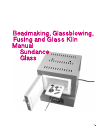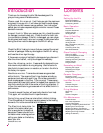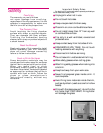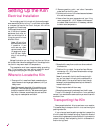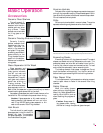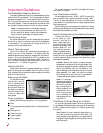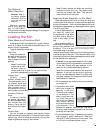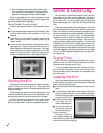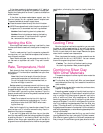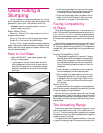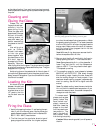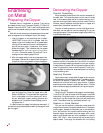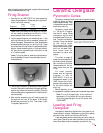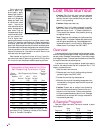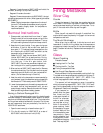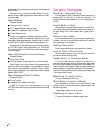
If the piece needs only shallow support of ¼” depth or
less, pour the alumina hydrate onto a ceramic fireclay shelf.
Support the fireclay shelf on three ½” posts to aid heat flow
under the shelf.
If the silver clay shape needs deeper support, pour the
alumina hydrate into an unglazed ceramic bisque bowl.
These are available at ceramic supply stores.
■
Place the ceramic bowl directly onto the kiln bottom.
■
NEVER use a glazed bowl to hold the alumina hydrate. If
the glaze runs, it can embed into the firing chamber.
Caution: Avoid breathing alumina hydrate dust.
Caution: Alumina hydrate can destroy the heating
element on contact. If it spills onto the firing cham
-
ber, remove with a vacuum cleaner.
Venting the Kiln
Silver clay by itself needs no venting. Load the kiln, close
the door,and leaveit closeduntil theclay silveris readyto re
-
move.
The kiln needs venting if you fire ceramics or glass with
the clay silver, or if you make hollow objects that contain a
core of organic materials.
Paper maché and paper clay are good core materials. Do
not use wax or styrofoam as a core. They emit harmful
fumes.
Rate, Temperature, Hold
Each brand of silver clay fires to a specific temperature
and hold time. This information is available from your silver
clay supplier.
Note: Hold time is the length of time that the rec
-
ommended temperature is maintained in the kiln.
Do not fire longer than the recommended hold, or
the silver will begin to overfire.
Besides selecting a temperature and hold time on your
kiln’s digital controller, you will also need a firing rate. (See
the separate digital controller instruction booklet.) Select a
Full Power rate if you are firing silver clay alone. If you fire
glass orceramics with thesilver clay, selecta rate bestsuited
for the glass or ceramics.
Note: Do not place silver clay into a kiln that is al
-
ready hot unless the clay is completely dry. The kiln
should be no hotter than 500°F/260°C when insert
-
ing the silver clay.
After the kiln begins firing, leave the door closed. Do not
open the door until it is time to remove the clay. Visual in
-
spection of the clay is unnecessary.
If you are firing glass with the silver clay, on the other
hand, you may need to check the fusingprogress of the glass
by opening the door ½” and looking inside. Look for just a
second or two. As you gain experience, you will be able to
program thecorrect temperature for thesilver clay andglass
combination, eliminating the need to visually check the
glass.
Cooling Time
After the clay silver hasfired to completion, you can crack
the door an inch to speed cooling. If you are firing stones,
glass,or othermaterialswith thesilverclay,it issaferto allow
the kiln to cool slowly with door closed. Remove the piece
when the kiln reaches room temperature.
Silver clay pieces that contain no other materials can be
removed from the kiln at 1100°F/593°C. You can remove
them with tongs and drop them into water.
Caution: Turn the kiln off before inserting tongs
into the firing chamber. Wear protective gloves.
Combining Silver Clay
With Other Materials
There are two ways to fire silver clay with other materials
such as glass:
■
Fire the silver clay first by itself. After you have cleaned
and polished the silver clay, fire it a second time with the
other material.
■
Fire the silver clay and other materials, such as a stone,
together in a single firing.
Enameling powder is easier to fire with the silver clay in a
second firing.See page12. Glass isoften fired withthe silver
clay in a single firing. Many types of glass will melt to the
point of overfire at silver clay temperatures. So before
combining glass and silver clay in a single firing, test a small
sample of the glass. To do this, fire the glass during a silver
clay firing, keeping the glass separate from the silver clay
piece. (This way you won’t ruin the silver clay piece.) Place
theglasspieces onaceramicfireclayshelf. Youmustcoatthe
shelfwith glassseparator, orotherwisethe glasssamplewith
embed into the shelf.
If the glass sample survives the firing, you can fire that
type of glass with silver clay in a single firing. Note, however,
that different types of glass fire to different temperatures.
Every time you fire a different type of glass, be sure to test.
9



